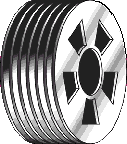 |
 |
| Home | Capabilities | Gallery | Discflo Pumps | DataBase Pumps | Contact Us |
History of the disc pump |
First 'disc pump' mechanism |
The disc pump concept dates back to 1850. A pump was invented in the US by Sargent, who took a series of 29 parallel discs spaced a few thousands of an inch apart, enclosed them with a metal band, and made a number of holes in the band to allow fluid to pass in and out (see Figure 1). It was the first example of a pump operating solely on the boundary layer/viscous drag principle. As far as pumping goes, though, it was not a great success. The idea was taken further by the Serbian-American inventor Nikola Tesla. He removed the metal band from around the discs, which improved the pump's performance, although he too insisted on keeping the spacing between the discs very small, believing that at a certain point the pump would stop pumping if the discs were spaced too far apart. This insistence on very narrow disc spacing greatly limited the pump's capabilities to pumping non-viscous fluids and then very inefficiently, so the idea was all but forgotten. Then in the 1970s, Max Gurth, an inventer in southern California, looked at the concpet again. He found that the disc spacing could be widened to as much as 20" [500 mm], and contrary to the expectations of theoretical pump experts, the boundary layer/viscous drag principle still applied at these distances. Moreover, flow remained pulsation-free and laminar. One of his most interesting findings was that, unlike other pumps, the disc pump became more efficient at higher viscosities, exceeding the efficiency of a similarly sized centrifugal pump with fluid viscosities higher than 250 cP. He took out the first patents in the late 1970s and founded the Discflo Corporation in 1982 to manufacture and market the pumps. The pumping mechanism, which is called the Discpac, originally used flat discs. In 1988, a second generation of Discpac, called the high head design, was developed and patented. It is better suited than the flat discs to severely abrasive fluids, air-entrained fluids, and fluctuating pumping conditions, such as large or sudden changes in flow rates. |
 First 'disc
pump' - a pump operating solely on the boundary layer/viscous
drag principles - was invented in 1850 in the US. First 'disc
pump' - a pump operating solely on the boundary layer/viscous
drag principles - was invented in 1850 in the US. |
Tesla's friction 'disc pump' |
|
 Around 1900, Nikola Tesla developed the
idea further. But he kept the disc spacing small, so the
pump was limited to pumping water. Around 1900, Nikola Tesla developed the
idea further. But he kept the disc spacing small, so the
pump was limited to pumping water. |
|
Original flat Discpac design |
|
|
|
High head Discpac design |
|
|
Technology in Pumps
 The original Discpac
design, the pumping mechanism at the heart of the disc
pump, was patented in 1982. It can have from two to
twenty discs, ranging in diameter from 8" [203mm] to
20" [508mm].
The original Discpac
design, the pumping mechanism at the heart of the disc
pump, was patented in 1982. It can have from two to
twenty discs, ranging in diameter from 8" [203mm] to
20" [508mm]. The high head
Discpac design, patented in 1988, produces higher flow
rates and discharge pressures than comparably-sized
plain discs. It is ideal for severely abrasive fluids,
air-entrained fluids and fluctuating pumping conditions.
The high head
Discpac design, patented in 1988, produces higher flow
rates and discharge pressures than comparably-sized
plain discs. It is ideal for severely abrasive fluids,
air-entrained fluids and fluctuating pumping conditions.